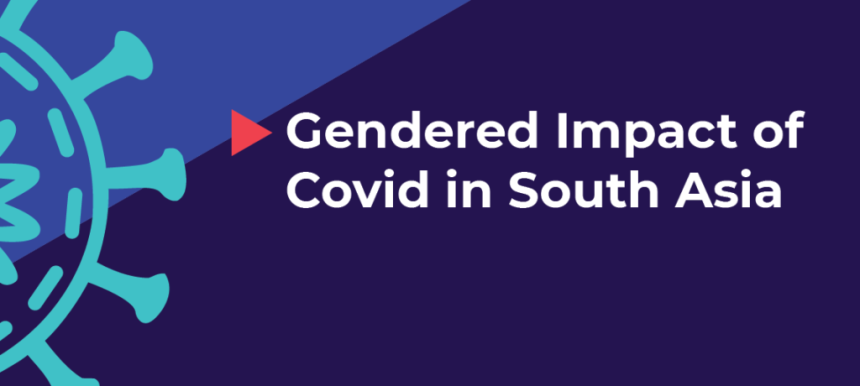The aftermath of the coronavirus pandemic has been mostly obstreperous. By the start of march 2021, there have been 117 million cases recorded, with almost 2.59 million deaths worldwide. While the lockdown enforced by the states, through their indigenous national government to curb the rapid proliferation of the virus has stunted the supply chains, halted agricultural undertaking, and slow-downed the economic activity, it has also severely impacted marginalized sections of the society, especially the women. A policy brief published by the United Nations (UN), on the impact of the COVID-19 over women states that the evidence suggests that female economic activity will have a more significant inverse effect than men.
Worldwide, women earn less, hold less secure jobs, and are more likely to be employed in the informal sector. About 740 million women globally work in the informal economy. Moreover, women have a reduced admittance towards the social safety nets. Hence, their adeptness to comprehend the economic shocks is low than that of men, making them more exposed and less resilient. Pandemic has worsened, the already grieved situation further for women; the articles sheds some light on the gendered impacts of COVID-19 on women.
Digital Drive:
Technology has singlehandedly proved as an efficient catalyst in transforming society. Access to information is one of the fundamental aspects of the liberal democratic system; it is the initial step towards empowerment. During the present pandemic, human motility has been cramped. Simultaneously, it has enhanced the reliability of digital platforms, it has become essential to be connected. Moreover, this pandemic has illustrated that technology is a medium for entertainment and an efficient communication and development platform.
As per the Global System for Mobile Communication Association’s (GSMA) Mobile Gender Gap Report released in 2020, the technology gender gap is substantial and recurring. It disclosed that in Bangladesh, 25% of women are less likely than men in accessing mobile phones. A similar picture in India and Sri Lanka stands at 20% and 7% respectively. Among the population with access to phones, 17% of women in Bangladesh are less likely than men to access the internet on the phone. This goes up to 50% in India, 40% in Sri Lanka. In Pakistan, 81% of the men and 50% of the women have mobile phones, yet out of those only 19% percent women have internet access, with an accumulative gender gap of 49% in internet usage. The report reflects society’s general tendency to alienate women from accessing technology, in this case, mere mobile phones.
This divide includes cultural and social factors, respective workloads, immobility of financial resources, and varied education, including access to COVID-19 related health advice amongst women. A Food and Agriculture Organisation report highlights that differences in possession of mobile, access to the internet, and educational procurement might be keeping some women away from potentially life-saving information. Women play a pivotal role in advancing hygiene routines in households alongside caring for their families. Thus, their admittance to authorized sources COVID-19 information is crucial.
Decision-making Power within Households:
Due to society’s cultural norms, women’s social standing and role link directly to their family’s decision-making power. In South Asian culture, men hold more power than women when it comes to decision-making. Most households have patriarchal order, whereby it is a common belief that men are the head of the house; men ordinate and women subordinate. The pandemic’s prevailing effect has influenced this culture on account of men being home. Their increased presence meant that household decisions, however little, are now compromised. Women who used to take small decisions in the household on their own, in the absence of their male counterparts, now have to face the scrutiny of the men in the family. A 2020, UN Women study found that there is a direct linkage between domestic violence and decision-making power within households. An exponential rise in domestic violence incidents worldwide during the pandemic has risen to the extent that the United Nations has announced it as a shadow pandemic. It is quite unlikely that many incidents of violence against women will go unreported because of lockdown and centuries old power dynamics.
Violence against Women (VAW)
The United Nations Population Fund has estimated that during the Covid-19 pandemic 15 million additional Gender Based Violence cases worldwide for every additional three months of lockdown are expected. This figure is based on a 20 percent increase in violence during lockdowns. Even with limited data, it is clear that the compounding effects of lockdowns and broader pandemic conditions facilitate violence and reduce victims’ ability to report incidents or seek help.
There are four ways the chances of violence against women (VAW) have increased during the COVID-19 Pandemic. Firstly, women’s exposure to perpetrators is through lockdowns limiting their ability to leave home. Women, in lockdown, have fewer chances of reporting violence to authorities or even confiding into their friends and co-workers. Secondly, long-term effects of school closures on child marriage. Globally, 15 million girls are married before they turn 18 every year. In South Asian countries, early female child marriages are quite common, most parents only delay their girls’ marriages due to their education. According to the most recent data available in ESCAP statistics, in Asia and the Pacific the percentage of women aged 20 to 24 who were first married before age 15 ranges from 0 percent to 22.4 percent. These figures are higher for the percentage of women 20 to 24 who were married before age 18: from 3.9 percent to 58.6 percent. The World Bank advocates that “one of the best ways to end child marriage is to keep girls in school.” With schools either transitioning to remote learning or closing altogether to avoid community spread of the novel coronavirus, girls may be at greater risk for marriage. According to UN women’s research, girls married before age 18 are more likely to experience domestic violence.
The third and the last way the Covid-19 pandemic increases women’s exposure to perpetrators is their disproportionate burden of care work and more time spent online. Globally, 70 percent of health care and social sector workers are women. Due to the pandemic, the high demand for healthcare services places many women in vulnerable positions, required to look after violent patients who are disproportionately male. The World Health Organization reports that between 8 percent and 38 percent of health workers suffer physical violence at some point during their careers, typically at the hands of patients or visitors. Under the high-stress environment, the Covid-19 pandemic creates with unknown medical risks and no cure or vaccine, there is a high likelihood that healthcare workers are facing increasingly desperate patients and family members, exposing them to a greater risk of violence.
The transition to remote work and learning has increased the amount of time women spend online. Although digital violence is an emerging area of study, preliminary information on online and information and communications technologies (ICT) facilitated VAW suggests that women and girls are more likely to experience cyber harassment.
Emotional health
Although infection and mortality data show that men are more probable to contract and die from the COVID-19 virus, the pandemic’s emotional impact disproportionately falls on women’s shoulders in most countries. A sharp rise in income loss and the effects of the lockdown on gender-based violence are among the factors that may be contributing to higher rates of stress and anxiety among women.
Surprisingly, as opposed to all other countries, Bangladesh recorded slightly more men who reported being affected mentally/emotionally than women. Male mental health was affected by 66% while women mental health was affected by 62%. In contrast, the situation for Pakistan is reversed; 66 percent of women stated that their mental health had been affected terribly.
Emotional health services have come to a standstill in the pandemic. According to the World Health Organization (WHO), almost 93% of the essential mental health services have come to a halt. WHO conducted a survey to identify the impact of the pandemic on emotional health. The result underscored a dire need for investment across the realm of mental health services. As, COVID-19 has the capacity to inflict neurological and mental complications, such as delirium, agitation, and stroke. Special measures must be taken by the government to ensure mental health of the citizens, whom importance during the Pandemic has been realized even more.
South Asia has the largest population of youth and adolescents in the world. The pandemic’s exogenous effects have impacted society in unprecedented ways such as economic crisis, rise in stark inequality, disruption of essential services, and low literacy rates. Of these negative impacts, Women have felt them the worst. They face increased risks of the digital divide, gender-based violence, poverty, school fallouts, unintended pregnancy, and child marriage. State policy responses have yet to address their specific needs and challenges. This situation must change. Governments need to bring forward policies, which must be specifically tailored to address the growing needs and challenges of women in South Asia.






